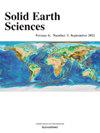Petrography and U/Th dating of travertine deposits in Bongongo (Cameroon volcanic line): Implication for paleoclimate, hydrothermalism and tectonism
IF 2
4区 地球科学
Q3 GEOSCIENCES, MULTIDISCIPLINARY
引用次数: 0
Abstract
The studied travertine deposits have been analysed using sedimentology, petrography and geochronology to evaluate their resurgence variation, Neotectonic reconstruction, hydrothermal/paleohydrology, and tectonic influence for their precipitation. These deposits display a dome structure with milimetric layers containing some dicotyledonous leaf prints mainly of angiospermic plants class and animal traces. Traces of gastropods fossil and imprinted plant leaves are seen scattered all over the samples. Microscopically, the travertine reveal laminae characterising a long spike-like dendritic millimetric crystals. The spike-like structure composed of crystals calcite enclosing putative microbial filaments which are longitudinal within some places, micrite partially filling inter-crystalline voids. The petrographic characteristics of the travertine corroborated with isotopic analyses, reveals processes such temperature variation, degassing variation, fluctuations of the physico-chemical fluid and dissolution as controlling factors to the formation of the different carbonates textures. Four units representing different sample points discloses ages of 19.839 ± 4.8 ka, 50.3645 ± 9.4 ka b2k, 2.00 ± 1.8ka b2k and 5.77 ± 1.7ka b2k. Conclusions drew from the study suggest that, (1) a forest vegetation type testifying to a humid climate prevailed at the time of the travertine precipitation, (2) there were repeated reactivation of fault systems as well as episodic high hydraulic head in the aquifers underlined by U-series dating that showthe presence of different spring systems generations in the travertine deposits (3) three phases of travertinization were disclose: first phase (Upper Pleistocene, ca 50 ka b2k), marked by significant and regular rainfall leading precipitation of massive travertine deposits, second phase (Between 50 ka b2k and 19 ka b2k), marked periodicity of rainfall forming laminated travertine, third phase (beginning of the Holocene between 5.77 ± 1.7ka b2k and 2.00 ± 1.8ka b2k), marked by obstruction of the main canal of circulation inducing a possible change of exsurgence forming new deposits recorded at the base of the dome (4) the travertine precipitation was influence by hydrothermal system and recent extensional tectonic activities owing to the presence of saline springs.
Bongongo(喀麦隆火山岩线)钙华矿床的岩石学和U/Th定年:古气候、热液作用和构造作用的意义
利用沉积学、岩石学和年代学等方法对所研究的石灰华矿床进行了分析,评价了其回潮变化、新构造重建、热液/古水文以及构造对其降水的影响。这些沉积物呈毫米层状的圆顶结构,含有以被子植物类为主的双子叶叶印痕和动物印痕。腹足类动物化石和植物叶片的痕迹遍布整个样本。显微镜下,石灰华显示出具有长尖状树枝状毫米晶体特征的层状结构。晶体方解石组成的尖状结构包裹着假定的微生物细丝,在某些地方是纵向的,泥晶部分填充晶间空隙。钙华的岩石学特征与同位素分析相吻合,揭示了温度变化、脱气变化、物化流体波动和溶蚀作用等过程是不同碳酸盐结构形成的控制因素。代表不同采样点的4个单元显示年龄分别为19.839±4.8 ka、50.3645±9.4 ka b2k、2.00±1.8ka b2k和5.77±1.7ka b2k。研究结果表明:(1)钙华沉积时期为森林植被类型,气候湿润;(2)u系列测年结果表明,断层系统反复活化,含水层水头间歇性高,表明钙华沉积存在不同的泉水系统世代;(3)钙华化的三个阶段:第一阶段(上更新世,约50 ka b2k),以显著而规律的降雨为标志,形成块状钙华矿床;第二阶段(50 ka b2k至19 ka b2k),以降雨形成层状钙华的周期性为标志;第三阶段(全新世初,5.77±1.7ka b2k至2.00±1.8ka b2k)。以环流主通道的阻塞为标志,可能会引起水流的变化,形成在穹窿底部记录的新矿床(4),钙华降水受热液系统和近期伸展构造活动的影响,由于盐泉的存在。
本文章由计算机程序翻译,如有差异,请以英文原文为准。
求助全文
约1分钟内获得全文
求助全文
来源期刊

Solid Earth Sciences
GEOSCIENCES, MULTIDISCIPLINARY-
CiteScore
3.60
自引率
5.00%
发文量
20
审稿时长
103 days
 求助内容:
求助内容: 应助结果提醒方式:
应助结果提醒方式:


